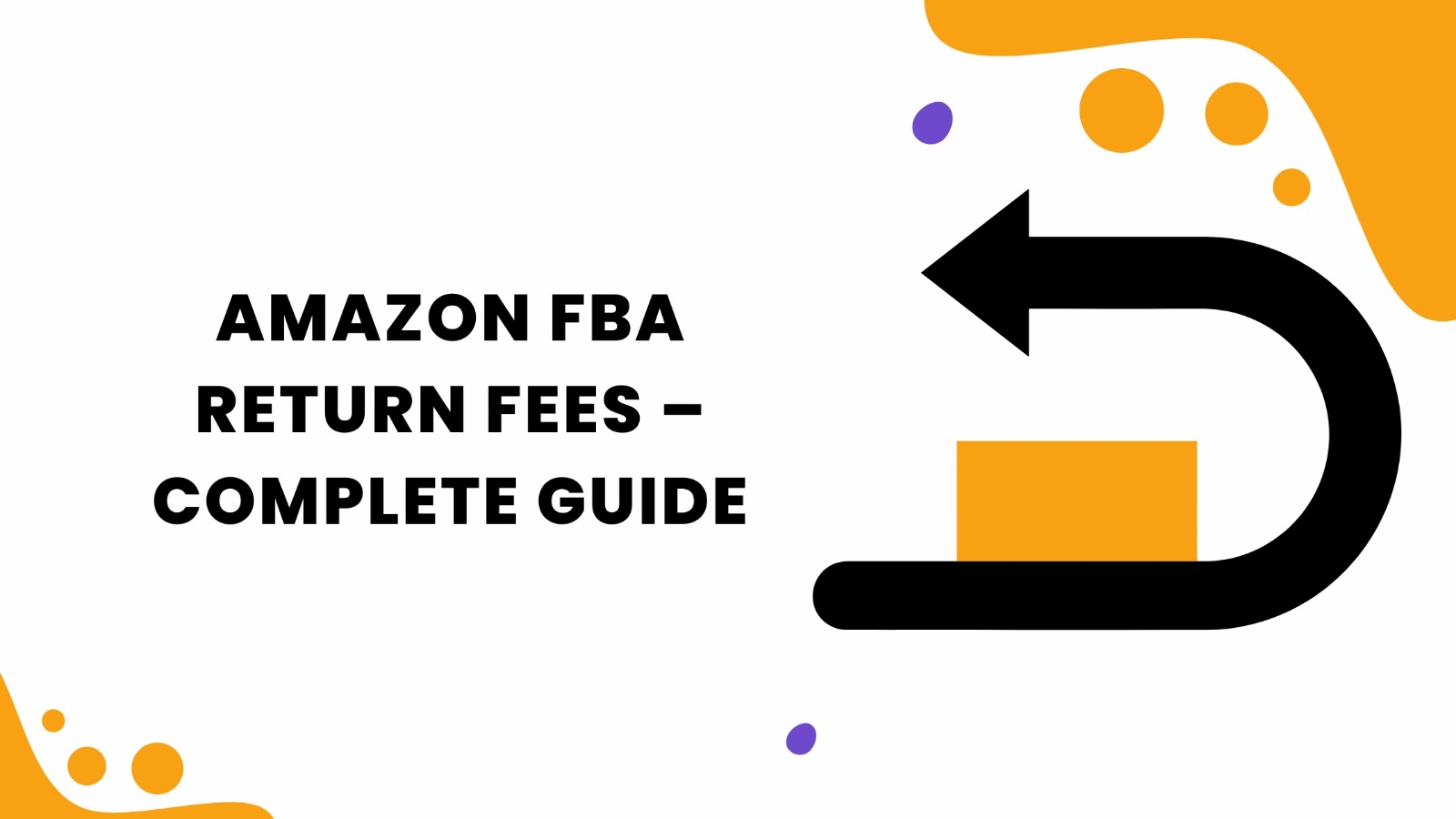Amazon FBA Return Fees – Complete Guide
Among the necessary considerations for sellers who use the FBA service provided by Amazon is the Amazon FBA return Fees. There is no denying that Fulfillment by Amazon, or FBA, has been a game-changer for eCommerce. Like everything in life, there is that one side of the coin that comes along with every benefit.
Understanding these fees is very important to maintaining profitability, more so in high-return markets. This article takes you deep into what these fees are, how you calculate them, and how to understand and minimize your business’ impact.
What Are Amazon FBA Return Fees?
Amazon return fees refer to charges that are charged to the sellers every time a customer returns a product. In case the customer receives a refund from Amazon, Amazon charges the seller for processing the return. This amount may depend on the type of product, size, and weight.
Fees for a return cover all kinds of direct and indirect costs associated with its handling and processing, including restocking, repackaging if required, and customer service. If your product is approved to join Amazon’s return policy program, then you have to pay Amazon FBA return fees whenever a customer returns your product. Nevertheless, it’s also good to know that not all products are allowed to get free returns though those that are included will incur a return processing fee on the side of the seller.
How are Amazon FBA Return Fees Calculated?
Some factors would determine a massive variation in Amazon FBA return fees. Traditionally, Amazon calculates return fees as defined below:
- Product category: High return rates are usually associated with product categories like clothing, electronics, and home goods. Such products may incur a higher return fee.
- Size and weight: Size and weight increase cost with large heavy products as it is a costly product to handle and restock.
- Why the return is being initiated: If it is Amazon’s mistake, such as incorrectly shipped. They typically do not pass these return charges to the seller. But if the customer changes his or her mind or does not like the product that they ordered, then the seller will bear the whole cost.
Generally, Amazon would send a notification regarding any Amazon FBA return fees to sellers via their account dashboard.
Managing Amazon FBA Return Fees
Although in Amazon FBA fees are something you have to deal with when selling through Amazon FBA, there are ways you could control and minimize them for an unscathed bottom line. Here are some strategies on how you can reduce the burden of return fees:
-
Optimize Your Product Listings
Another way to minimize returns is by ensuring the product description of your listings is detailed and accurate. This happens because most returns take place since the product does not live to the expectation of the customer. Providing clear images, detailed descriptions, and accurate sizing ensures they don’t return for the reason that their expectations were not met. This shall directly reduce the amount of return fees on account when selling on Amazon FBA.
-
Quality Improvement
Low return rates are typically associated with high-quality products. Therefore, ensuring that your products meet the expectations and standards of quality will automatically minimize the chances of returns. Put your time and money into good quality control and testing before shipping to an Amazon warehouse so you minimize costly returns and Amazon FBA return fees.
-
Good Customer Service
The best way to avoid return is to provide great customer service. For example, when a customer complains about an issue with a product, it will be solved through customer support before they even have to open a return. This will save you the cost of unnecessary Amazon FBA return fees. You might even only have to provide troubleshooting assistance or replacement parts to cure the problem without having to do a full return.
-
Trend Analysis of Returns
Monitor your return rates periodically. Amazon FBA provides return data that will help you to establish the cause of high returns. For example, you can recognize that product defects or misleading descriptions are the frequent causes of return. Then you can work on that trend and reduce the future returns with corresponding costs on return fees at Amazon.
-
Choose Relevant Categories of Products
Some product categories have a higher return rate, and they are clothing and shoes. A good fit, personal preference, or minor damage can easily tip the balance in the minds of people who had an initial desire for products in these categories. Concentrate on categories with lower rates if possible. It will help keep your exposure to Amazon FBA return fees down.
-
Proper Packaging
Many times, return happens due to damaged products. Proper packaging of products will prevent damage during shipping and ensure that returns on account of poor packaging are minimized, thus reducing the Amazon FBA return fees you incur.
Common Mistakes that Lead to High Amazon FBA Return Fees
Several unnoticed Amazon FBA return charges are being raised by avoidable mistakes made by several sellers. Some common ones have been listed below along with how you can avoid them:
- Poor Inventory Management
Shipping of defective or low-quality products to the fulfillment center at Amazon is bound to raise higher rates of return. You must have a proper quality control system in place, ensuring that only the best products are shipped to Amazon.
- Inaccurate Product Information
Misrepresented product listings due to which the customer is informed that the item may be returned and increased in returns. Whether it is false dimensions, misleading photos, or obscure descriptions, these are a few problems that result in more returns and more Amazon FBA return charges.
- Ignorance of Return Data
Amazon shows detailed reports on return trends and reasons for returns. If you overlook this information, you miss fixing problems and lowering your return rates. You’ll be monitoring these trends to make all necessary adjustments to strategies with a view to reducing Amazon FBA return fees.
Amazon FBA Return Fees: Minimize using Policy Awareness
The key to avoiding high fees when your products are returned in an Amazon FBA is understanding Amazon’s return policy. You may not be able to control the reasons for a return by a customer, but you can develop very clear return policies that align with the published Amazon Guidelines and the needs of the business.
For instance, some sellers also want to sell items that do not have free returns, especially those selling in categories that are notorious for their high return rates. In any case, it is a double-edged sword since allowing easy returns can be very effective in increasing customer satisfaction.
Also, if Amazon is at fault for a return-for example, shipping the wrong item sometimes you can get refunded for the Amazon FBA return fees paid. Pay attention to these so you know when you are to be refunded or have fees waived.
Conclusion
Running a well-set FBA business requires the management of Amazon FBA return fees. Although such charges are unavoidable, measures can be taken to reduce their effects on your business. Optimizing your product listings and improving the quality control system will be among the several ways to have lesser return rates and maintained profit margins. Other methods that include maintaining low return percentages and protecting profit margins include analyzing trends in return rates and giving good customer support.
That way, you will be optimizing your profitability while at the same time delivering value to the customer, for you know why Amazon FBA return fees occur and what steps can be employed to minimize the returns. It’s much like knowing all approaches to selling on Amazon to keep ahead of them while still optimizing business and cutting costs that may have otherwise increased unnecessarily.
You may also want to know about: What is the difference between Amazon seller and FBA?



